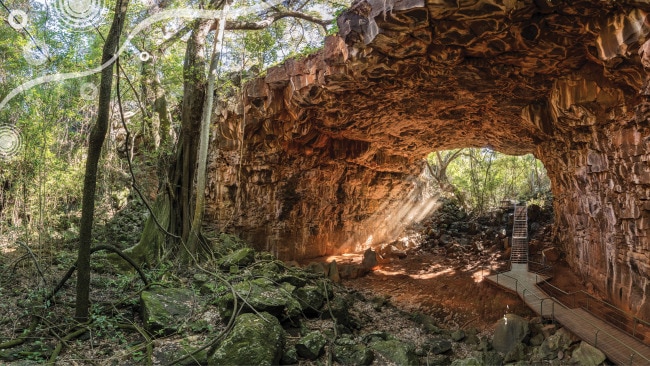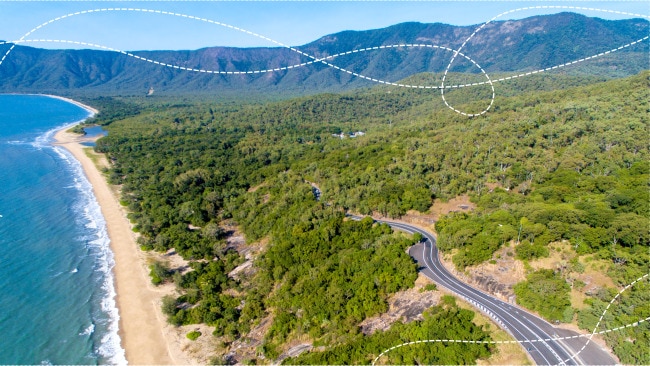How one project is saving the Reef’s green turtle population
IT TAKES them 35 years to migrate back to Raine Island to lay their eggs, but once the green turtles arrive, many are sentenced to their death. Here’s how the Raine Island Recovery Project is, as David Attenborough says, assisting “one of the most spectacular ocean migrations on the planet”.

It takes them 35 years to migrate back to Raine Island to lay their eggs, but once the green turtles arrive, many struggle to survive. Here’s how the Raine Island Recovery Project is, as David Attenborough says, assisting “one of the most spectacular ocean migrations on the planet”.
It can take the best part of a day to get to Raine Island by boat, depending on which port you leave from.
That’s nothing compared to the journey undertaken by the green turtles that flock there to nest.
It takes them at least 35 years to make their way back to the island where they were born, which is about 620km north of Cairns and 80km offshore on the outer Great Barrier Reef.
That’s how old a female turtle has to be before she is mature enough to lay eggs. Before she reaches that age she runs a decades-long gauntlet in the open ocean, avoiding sharks and birds, pollution, boat strikes, human hunters and habitat destruction.
It’s a miracle any turtle survives to adulthood. If they do, the females head back to Raine Island to lay their eggs and complete the circle of life.
The tiny cay is the biggest nesting ground in the world, responsible for about 95 per cent of the northern reef’s population of green turtles.
However, when the turtles arrive on the cay, they are faced with a number of challenges – the eggs can be inundated with water, turtles can get trapped on rocky cliffs, and even die from heat exhaustion on the beach.
But thanks to a successful partnership between science, government, the corporate sector and Traditional Owners, the green-shelled giants are nesting and hatchlings numbers are growing.
The people involved are part of the Raine Island Recovery Project, a five-year, $7.95 million collaboration between BHP, the Queensland Government, the Great Barrier Reef Marine Park
Authority, Wuthathi and Kemerkemer Meriam Nation (Ugar, Mer, Erub) Traditional Owners and the Great Barrier Reef Foundation that began three years ago.
Associate Professor Mark Hamann is one of those taking part. He teaches Marine Biology at Townsville’s James Cook University, and has recently returned from a mission to place satellite trackers on some of Raine Island’s turtles.
He and his colleague tagged 21 turtles, which join another 20 or so whose trackers are programmed to download information about their movements every 24 hours.
Professor Hamann has made about 10 trips to Raine Island since the early 1990s, but until this recent visit hadn’t set foot on the cay for about 15 years.
He was impressed by the work done to restore the environment and the measures taken to protect the turtles, the most noticeable being the cliff-top fencing.
The fences are designed to stop the turtles tumbling off the island’s “cliff” and landing on their backs.
“Turtles tend to flick sand and rocks around and create ramps that enable them to get up on top.
“Once up there they don’t necessarily come down the same way. They can topple off and land on their backs.
Another problem has been tidal inundation, forcing turtles to nest in sand that is inundated at high tide, killing the newly-laid eggs.
Work has been done to raise the beach profile by shifting a mountain of sound into the nesting areas, and monitoring has shown there has been a dramatic increase in hatchling rates.
The fences and landscaping are giving the turtles a fighting chance, but more work is needed.
“There are still many things we don’t know,” said Professor Hamann.
“Part of the research in this project is to try and answer some of those ecological uncertainties and try to get a handle on some of the causes of nest failure, and the reasons why turtles are finding it hard to lay eggs.”
The partnership supports on-ground work as well as further research.
“We first identified there were problems with the turtles on Raine Island in 1996,” Professor Hamann said.
“It’s really nice to see the investment happening and the investment being well co-ordinated and well led.
“Good for us, good for the island. Any kind of partnership where you can leverage funding and expertise from multiple sectors is really the way research is going to survive in places like Raine Island.”
The broader project helps build resilience of the Great Barrier Reef through the natural environment and through engagement with Traditional Owners.
An important aspect of the work being done is the involvement of the Traditional Owners, who view Raine Island as a significant cultural site.
“By being directly involved in the project and travelling to the island with the scientists, it gives our people a better understanding of how to best look after the island through science,” said Wuthathi ranger Peter Wallis.
Mr Wallis and Kemerkemer Meriam Nation ranger Jimmy Passi, travel to the island regularly to represent their people and support the teams carrying out sand testing, sand movement, cultural heritage monitoring, turtle monitoring and satellite tracking.
“As an Indigenous nation, our involvement helps us learn from the scientists but it is good for them too, to learn from the Traditional Owners,” said Mr Wallis.
“I think they get a better understanding of our respect for the country and that we are all the same. There is no black or white, it is just about respect for the land and respect for others, which is how we have been brought up.”
Originally published as How one project is saving the Reef’s green turtle population



